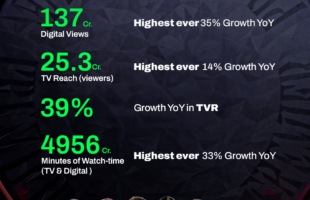Digital Television Russia (DTR) is growing fast both at domestic and global level – and this year, for the third time, it will attend the MIPCOM 2017. Meet Dmitry Mednikov, DTR’s Chairman, to find out what has been done up to now and what are the next steps of a strategy to become market leaders.
MIPCOM 2017, the world’s most influential gathering for media industry players, is scheduled from October 16 to 19, 2017 at the Palais des Festivals in Cannes, France – and Digital Television Russia, a regional media producer aiming to consolidate its international presence, knows it is “the place to be” to show its products and to forge strong bonds within the industry.
Owned by the Russian Television VGTRK and Rostelecom, OAO Digital Television Russia (DTR) has quickly become the leading basic and premium Pay TV broadcaster in its domestic market (with the 34.6 % share) thanks to a comprehensive platform for cartoons and factual entertainment offering 21 channels. Since the foundation in 2012, the company’s management has led a successful transition from a local production studio into a creative player on the international stage. Dmitry Mednikov, Chairman of DTR’s Board of Directors, explains to us the company’s path up to now and its direction for the future.
In the past years, DTR has put in place an extensive support network throughout all Russia by identifying several partner organisations taking care of different aspects of the TV industry in Russia: today, the group is formed by more than 1000 SMEs, among which there are larger service providers, research centres and leading animation studios. The most successful partnerships are the one with “Zero Plus Media”, the main player in the animation content licensing market, and the one with STV, the Russian leader in the retransmission of thematic satellite channels.
After building and nurturing the domestic ecosystem, we have turned our attention onto the export industry. Our export’s core grounds are the constant adaptation of the content for the local public, the promotion of the brand at an international level and the research of international and mutually advantageous partnerships.
We have indeed pursued international growth by forging partnership with fellow broadcasters in India, China and Brazil to facilitate the adaptation of the brands for the local markets.
Our trade with the Asian region in particular is increasingly prolific. We recently signed an agreement for the distribution of our animated content with EMTV, the largest media holding in Papua New Guinea and in July 2017 we attended the ChinaJoy International Digital Entertainment Expo for the first time. Moreover, on September 8 we signed two cooperation agreements with the representatives of Dazzle Interactive Network Technologies, a subsidiary of state-owned telecommunications company China Telecom specializing in the creation and promotion of mobile apps and games. The agreement marks the transfer of rights of the largest pool of Russian animated series, mobile games, and applications owned by Digital Television Russia to the Chinese company, which will kick off by the end of the year.
To become more competitive the management decided to diversify the offer to its customers and to explore the universe of interactive games and mobile services. On the one hand, in 2015 we kicked off the Interactive MOOLT project: our experts produce interactive video games and educational mobile apps for kids out of the most successful series we broadcast, such as “Be-be-bears” and “Paper Tales”. The video games and apps are focused on children’s learning process, have a high educational value and comply with the standard parental control.
One the other hand, DTR has provided its customers with a wide choice of online and mobile recommendation services.The Interactive MOOLT project was started out to create educational mobile apps out of the most popular cartoon series broadcast by DTR. The experts have created eight interactive apps that are available and well-rated in the both the most popular mobile operating systems, iOS and Android. The apps have reached more than 10 million downloads in the domestic market and benefit of a 2 million customers audience per month.
Up to now, we have decided not to develop games and solutions for gaming consoles because several market assessments proved that there is no demand for these products by the national consumers.
Kids’ television in our country is generally witnessing a rapid development. As far as DTR is concerned, according to the analysis of media measurement data (TNS) in March 2017, our cartoon channel MOOLT grows at a record pace. We estimate that the growth will be organic throughout 2017 and if the achieved indicators remain stable, we assume that MOOLT will be the leading cartoon channel in the Russian television market at least within the next five years.
In addition to that, DTR disposes of plenty of modern research tools and practices for both the domestic and international market. The MOMRI Institute focuses on analysing modern media consumption for three population targets – children, adolescents and the generation of 46+ – both on the foreign and Russian markets, whereas the Analytical Centre ACSM takes care of studying the pay TV sector and the consumption of pay TV channels overall. Therefore, as a short-term goal, DTR envisages to actively increase its competence in the domain of collection and analysis of Big Data so to remain ahead of its competitors.
The main goal is to repeat the success of last MIPCOM and MIPJunior, when our cartoon series “Be-be-bears” and “Fairy Patrol” were ranked in the list of the top-30 most popular programmes worldwide, and therefore to boost our international profile, strengthen our existing partnerships and get in touch with new interlocutors. This year, MIPCOM is kindly giving us the opportunity to premiere the first episode of our new kids’ fantasy series ‘Heroes of Envell’.
In the near future, the video consumption in digital environments is expected to increase both on pay TV and through various OTT services on desktop and mobile environments. Likewise, competition among products targeted on the 18-34 age range will sharply increase, not only for TV programs but also for interactive games and educational mobile apps that address the young audience and permits the broadcasters to monetize their brands.
Concerning digital television, already the 75% percent of Russian households have a pay TV connection, which entails that growth reserves in new households is almost exhausted. However, this market saturation will be compensated by a growing tendency to have more than one TV per family, e.g. when parents decide to buy their children a personal TV.









